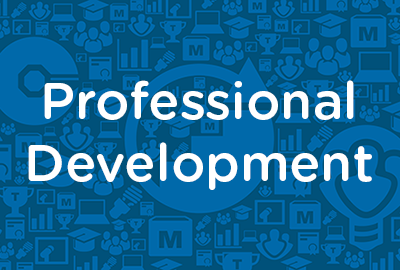 |
Interviewing Skills: Evaluating and Deciding (Instructor Guide) |
0.67 |
When determining which candidate will be most successful in the job and your organization, you must complete two important steps. First, you should assess each candidate’s experience and past performance, and compare them to the job’s success factors. Then, you should compare candidates with one another to identify the one with the best fit for the job and culture.
In this course you will learn to: identify the types of bias and the steps to evaluate a candidate, and identify several criteria for ranking candidates.
This Instructor's Edition of this course includes notes and suggestions to assist you in presenting the material, whether in an in-person classroom setting, or as an instructor-led online or distance-learning course. It also provides you with the answers to questions found in mid-lesson activities, as well as in the quiz that concludes the course. |
 |
Course 05: Guiding School-Age Children in Groups |
2.00 |
When large numbers of children are involved in the program, it is challenging to create and deliver school-age program activities that can meet the needs of all children. The key to success is taking a systematic approach to program planning. It is important for staff to understand how to select appropriate activity options and use effective management strategies that make it possible to offer a balanced variety of simultaneous activity options. This understanding will help staff plan and implement a program that effectively supports, nurtures, and guides individual differences and fosters positive interaction among children in groups. |
 |
Guiding School-Age Children in Groups: Supervision and Boundaries |
1.00 |
When large numbers of children are involved in the program, it is challenging to create and deliver school-age program activities that can meet the needs of all children. The key to success is taking a systematic approach to program planning. It is important for staff to understand how to select appropriate activity options and use effective management strategies that make it possible to offer a balanced variety of simultaneous activity options. This understanding will help staff plan and implement a program that effectively supports, nurtures, and guides individual differences and fosters positive interaction among children in groups. |
 |
Guiding School-Age Children in Groups (Collection) |
2.00 |
When large numbers of children are involved in the program, it is challenging to create and deliver school-age program activities that can meet the needs of all children. The key to success is taking a systematic approach to program planning. It is important for staff to understand how to select appropriate activity options and use effective management strategies that make it possible to offer a balanced variety of simultaneous activity options. This understanding will help staff plan and implement a program that effectively supports, nurtures, and guides individual differences and fosters positive interaction among children in groups. |
 |
Guiding School-Age Children in Groups |
2.00 |
When large numbers of children are involved in the program, it is challenging to create and deliver school-age program activities that can meet the needs of all children. The key to success is taking a systematic approach to program planning. It is important for staff to understand how to select appropriate activity options and use effective management strategies that make it possible to offer a balanced variety of simultaneous activity options. This understanding will help staff plan and implement a program that effectively supports, nurtures, and guides individual differences and fosters positive interaction among children in groups. |
 |
Guiding School-Age Children in Groups: MAPs and DDADA |
1.00 |
When large numbers of children are involved in the program, it is challenging to create and deliver school-age program activities that can meet the needs of all children. The key to success is taking a systematic approach to program planning. It is important for staff to understand how to select appropriate activity options, and use effective management strategies that make it possible to offer a balanced variety of simultaneous activity options. This understanding will help staff plan and implement a program that effectively supports, nurtures, and guides individual differences, and fosters positive interaction among children in groups. |
 |
A Critical Look at Family Child Care Spaces (CDA 1) |
2.00 |
When play problems occur over and over, child care practitioners need to be able to step back and look critically at their space arrangement to see if that is the source of the problem. Explore some key elements to consider in child care space arrangement that include types of spaces and their uses, and arranging activity areas in a room to meet the goals of your program. This course is designed to be part of a Child Development Associate (CDA) Credential™ curriculum. It covers CDA Subject Area 1: Planning a Safe, Healthy Environment to Invite Learning. This course can also be taken as a stand-alone learning event, or as part of a broader early childhood education curriculum.
|
 |
Course 30: Creating and Managing Budgets in School-Age Programs |
2.00 |
When program budgets are developed through a careful, step-by-step process, they become valuable planning tools. By using effective budget planning tools and strategies, OST professionals can make realistic projections about the program’s financial stability and design strategies for generating and allocating resources to support the program’s vision and mission. It is important for OST professionals to understand that the budget process is ongoing. It involves linking financial goals to program goals, identifying program priorities, allocating resources effectively, using reliable methods for calculating potential expenses and revenues, monitoring performance against projections made, and making needed changes and adjustments for the future. |
 |
Creating and Managing Budgets in School-Age Programs |
2.00 |
When program budgets are developed through a careful, step-by-step process, they become valuable planning tools. By using effective budget planning tools and strategies, school-age care professionals can make realistic projections about the programs financial stability, and design strategies for generating and allocating resources to support the programs vision and mission. It is important for school-age care professionals to understand that the budget process is ongoing. It involves linking financial goals to program goals, identifying program priorities, allocating resources effectively, using reliable methods for calculating potential expenses and revenues, monitoring performance against projections made, and making needed changes and adjustments for the future. |
 |
How to Manage Emotions |
1.00 |
When students manage emotion, behavior manages itself. Since emotions are a powerful driver of behavior, behavior management strategies that do not empower students with emotional literacy will do little to help students gain insight into their behaviors. When we ignore, inhibit, or invalidate emotion, we deny students (and ourselves) the opportunity to learn to appropriately express emotion. Only when we invite emotion can we then instruct emotion. |
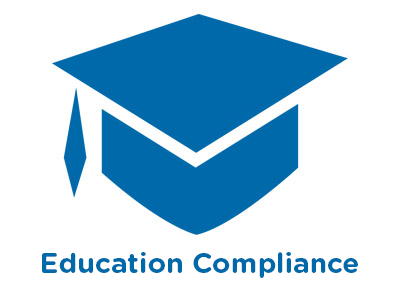 |
Clery Act |
1.50 |
When we talk about the Clery Act, we are actually referring to the Jeanne Clery Disclosure of Campus Security Policy and Campus Crime Statistics Act, and a series of other security-related disclosure requirements contained in section 485 of the Higher Education Act (20 USC §1092). The Clery Act requires colleges and universities to track and disclose information about crimes that occur on or near campus.
The basic requirements of the Act fall into six categories:
1. Campus crime reporting.
2. Timely warning notices.
3. Emergency notifications and emergency response testing.
4. Fire safety reporting and missing student procedures.
5. Notices to prospective students and employees.
6. Policy statements.
We’ll address each of these categories throughout this course. |
 |
Including Children and Youth with Disruptive Behaviors |
2.00 |
When working with children and youth, we encounter a wide range of behaviors. Effective behavior guidance strategies can help reduce the amount of time and energy spent addressing disruptive behaviors in the program. During this course, participants will explore the challenges of children and youth with disruptive behavior and learn strategies for effectively addressing these behaviors. |
 |
Advanced Interpersonal Communication: Supervisors |
0.75 |
When you think of a supervisor, you probably think of your immediate boss. However, in the workplace, most people have several supervisors. Your workplace might be divided into teams, departments or divisions. Within each level, there is a supervisor to whom you are accountable, even if you do not deal with that person on a day-to-day basis. Company executives and board members can also be considered supervisors because they might have the power to make decisions regarding your employment, salary, promotions, and work assignments. It is important to communicate effectively with all of your supervisors to maintain an efficient workplace and to be able to promote your own ideas for improvements.
In this course you will learn to: identify the types of ineffective supervisors and ways to interact with them, and negotiate a raise with a supervisor and offer an effective resignation. |
 |
Advanced Interpersonal Communication: Supervisors (Instructor Guide) |
0.75 |
When you think of a supervisor, you probably think of your immediate boss. However, in the workplace, most people have several supervisors. Your workplace might be divided into teams, departments or divisions. Within each level, there is a supervisor to whom you are accountable, even if you do not deal with that person on a day-to-day basis. Company executives and board members can also be considered supervisors because they might have the power to make decisions regarding your employment, salary, promotions, and work assignments. It is important to communicate effectively with all of your supervisors to maintain an efficient workplace and to be able to promote your own ideas for improvements.
In this course you will learn to: identify the types of ineffective supervisors and ways to interact with them, and negotiate a raise with a supervisor and offer an effective resignation.
This Instructor's Edition of this course includes notes and suggestions to assist you in presenting the material, whether in an in-person classroom setting or as an instructor-led online or distance-learning course. It also provides you with the answers to questions found in mid-lesson activities, as well as in the quiz that concludes the course. |
 |
Bony Fishes Collection |
10.00 |
Whether they are cruising the vast open sea, blending in with the bottom, lurking in the kelp beds, hiding in the coral, or fighting their way upstream, fish live in a world that’s vastly different than ours. In the Bony Fishes Collection, we’ll dive into this world. You’ll explore:
• Bony Fishes Module 1: Physical Characteristics
• Bony Fishes Module 2: Distribution and Habitat
• Bony Fishes Module 3: Ecology and Behavior
• Bony Fishes Module 4: Reproduction and Development
• Bony Fishes Module 5: Conservation.
|
 |
Job Search and Networking |
1.50 |
Whether you're looking for your very first job, a different position in your field, or planning to switch to a new career, searching for a job can be a big challenge. While there's no easy way to find a job, the right combination of job search strategies can make the process more manageable.
In this course, you will learn different techniques to assist you in searching for a job. This will include utilizing technology and developing both your personal brand and your professional network. |
 |
Managerial Leadership: Coping Through a Change Process |
1.00 |
Whether your employees perceive change as positive or negative, you might encounter an emotional response from them. They will have many questions regarding their roles, competencies, and, possibly, even their futures. Your employees might feel they are being forced out of a comfort zone, and they might experience a loss of familiarity. Typical responses during a change include feelings of doubt, anxiety, fear, and anger. Sometimes, changes in the workplace can trigger a severe emotional response.
In this course you will learn to: respond to distress and reduce stress, and succeed through failure and deal with mistakes. |
 |
Managerial Leadership: Coping Through a Change Process (Instructor Guide) |
1.00 |
Whether your employees perceive change as positive or negative, you might encounter an emotional response from them. They will have many questions regarding their roles, competencies, and, possibly, even their futures. Your employees might feel they are being forced out of a comfort zone, and they might experience a loss of familiarity. Typical responses during a change include feelings of doubt, anxiety, fear, and anger. Sometimes, changes in the workplace can trigger a severe emotional response.
In this course you will learn to: respond to distress and reduce stress, and succeed through failure and deal with mistakes.
This Instructor's Edition of this course includes notes and suggestions to assist you in presenting the material, whether in an in-person classroom setting or as an instructor-led online or distance-learning course. It also provides you with the answers to questions found in mid-lesson activities, as well as in the quiz that concludes the course. |
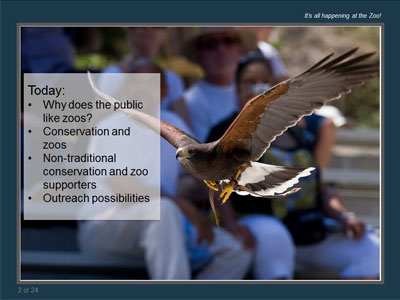 |
Building a Broader Base for Zoo-Based Conservation: Engaging Non-Traditional Conservationists |
1.00 |
While it is often thought of as an activity and ideology dominated by tree-huggers, conservation should have a much wider base of participation than is often the case. Hunters, fishers, veterans, and people across the political spectrum comprise an under-developed source of support for conservation projects. In this webinar, we will focus on outreach and messaging approaches that address this opportunity for zoos, as well as the larger conservation community. |
 |
Wildlife Ambassador Management |
2.00 |
Wildlife Ambassador Management will review the range of program animal roles in zoos and aquariums, the risks and rewards, the challenges and the considerations necessary for a program that follows best practices. The class will focus on animal acquisitions, animal handling policy, management practices for meeting the program animal’s social, physical, behavioral and nutritional needs as well as the safety of the animals, guests, and staff. |
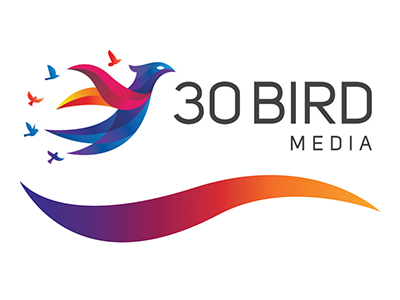 |
ITIL® 4 Foundation |
24.00 |
With more than 1,500,000 certified professionals worldwide, ITIL (IT Infrastructure Library) is the most widely established approach to IT Service Management. It provides a set of best practices for identifying, planning, delivering and supporting IT services to businesses and can be applied to nearly all organizations. ITIL 4 is fully compatible with ISO/IEC 20000, the first international service management standard for organizational certification and compliance.
The 30 Bird ITIL 4 Foundation course provides IT leaders, management, and support staff with a comprehensive introduction to the core concepts of ITIL 4. It is designed to equip students with a practical understanding of ITIL 4 key concepts, principles, and practices that enable modern IT-enabled services in today’s digital economy.
This course is based on the latest ITIL 4 best-practice guidance and will prepare the attendee for the ITIL 4 Foundation exam normally given at its conclusion. Candidates who wish to acquire knowledge in the theory and practices of the ITIL 4 management framework. This knowledge is also required if the candidate wishes to pursue any of the ITIL 4 certification schemes.
There are no specific prerequisites for this course. However, some basic knowledge of management theory can be helpful. After completing this course, you will know:
- What ITIL is; how it fits into the service management framework; how it has evolved over the years; and about the ITIL service value system
- The key concepts of ITIL service management, and how ITIL guiding principles can help an organization to adopt and adapt ITIL service management
- The four dimensions of ITIL service management
- The purpose and components of the ITIL service value system, the ITIL guiding principles, and governance
- The activities of the service value chain, and how they interconnect, and the key concepts of continual improvement
- The various ITIL practices and how they connect to value chain activities
NEW: Release 2.0 includes Sample Exam Papers in the book. Previously available only via download, the sample exams address all the topics covered in our ITIL 4 Foundation course. The questions are worded exactly as they appear in the official ITIL 4 Foundation exams. The Sample Exam Rationales (available via download) provide all the answers to the exam questions, as well as the rationales behind the correct answers. The sample exam questions, answers, and rationales are designed to best prepare you for taking the actual ITIL 4 Foundation exam once you've completed the course. |
 |
Creating an Inclusive Program |
2.00 |
With planning, training, and support, program staff can successfully include many children with special needs. Program staff must develop the skills necessary to assess the environment, materials, equipment, and activities to make the necessary modifications and accommodations so that all children and youth in their programs are successful. During this course, participants will discuss the law regarding inclusion as well as the attitude and reasonable accommodations needed to create an inclusive environment for children and youth with special needs. |
 |
Cybersecurity Fundamentals |
1.00 |
With the increasing use of technology in all facets of life, the internet has quickly become a necessity in doing business, getting an education, providing medical care, and operating on a daily basis. The internet is essential to most industries and sectors that you could work in. This importance and usage also bring along the negatives of the internet. Cyber attackers can steal information from people who are not careful nowadays and you need to be able to protect yourself.
This course provides information on the internet and how to mitigate the risks of operating online to avoid putting yourself in danger. In addition, you will also learn about how to protect your data and respond effectively to any sort of cybersecurity incident. |
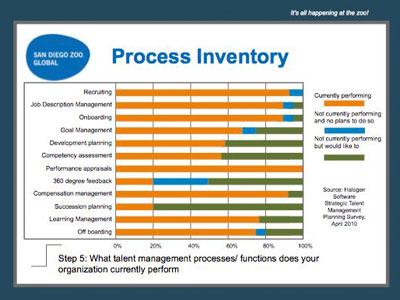 |
Mapping Your Performance and Talent Strategy for Results |
0.50 |
Without a "HR strategic talent management plan" tied to organizational goals, HR teams struggle to play a strategic role in their organization and talent management activities. Make the most of your only true sustainable competitive differentiator – your workforce. Learn to:
- Identify organizational goals/priorities. Define HR goals/priorities.
- Identify organizational drivers and challenges
- Identify gaps
- Articulate talent management processes/functions your organization currently performs
- Measure results. Communicate successes/contributions.
|
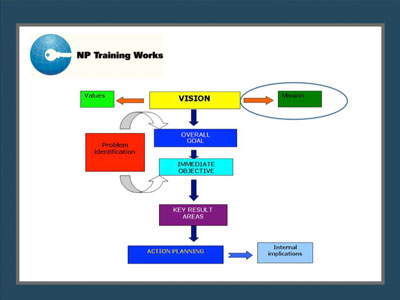 |
Creating and Implementing an Effective Strategic Plan for Your Organization |
1.00 |
Without strategic direction it is hard to get where you want the organization to go. This Webinar offers you a process for reaching your organizational goals. Strategic plans help your organization, or department, set the roadmap to make a significant mission impact. Through this Webinar you will learn a model for completing a Strategic Planning process in your organization. It covers the entire process from planning to defining the strategic framework and then creating a process for implementation activities. You will learn how to create a strategic framework that gives the activities coherence and direction, ensuring that your strategic plan becomes a living, breathing document that is fully utilized in the organization. You will also learn how to involve your board, staff, and other important constituencies in the process to increase your chances of successful implementation. In addition, you will receive leave-behinds that give you practical exercises and instructions to use during your strategic planning process. |


























